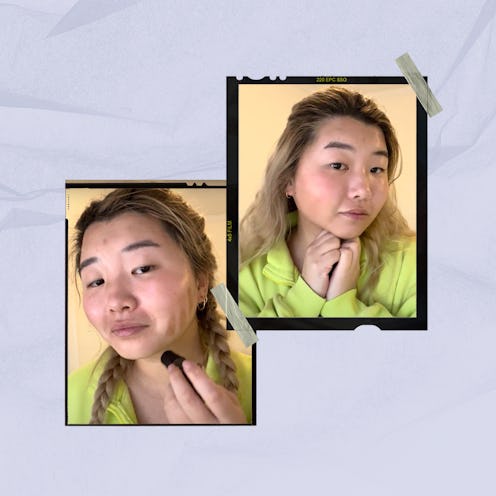Beauty
I Tried TikTok's Vertical Contouring For Round Faces Hack
Here’s the verdict.

As an Asian-American, I have always looked more on the youthful cherub side (no complaints here), which has made contouring extra tricky. So when vertical contouring started popping up on my FYP, I was immediately intrigued: The makeup sculpting technique is tailored specifically towards folks with round faces. With over 1.7B views on TikTok, I had to try it for myself.
According to celebrity makeup artist Taylour Chanel, shading from the hollow of the cheeks downward toward the jaw softens the round angle of the lower face, creating a more chiseled appearance. With traditional contour, on the other hand, you brush upwards in a slanted horizontal line that enhances the shadows from the hollow of the cheeks to the ears (so the vertical technique is the exact opposite).
Chanel does note that vertical contouring is best when used for big events or photoshoots. “[It] looks amazing on camera, but sometimes, if the shade isn’t right or the blending isn’t done well, it can look a bit harsh in person,” she tells Bustle. Still, if you blend well enough, you can potentially sculpt your face quite nicely for a day at the office.
If you’re a round-faced girlie like me, read on for the insider intel on exactly how to vertically contour like a pro — and what happened when I tried it.
How To Vertically Contour Your Face
Essentially, all you have to do is grab your contouring product and draw vertical lines on each side of your face from your cheekbones and down to your jawline — that’s it.
Still, regular contouring is hard enough, so if you’re not confident that you can blend well, approach this trend with caution. “As mentioned, shade choice is key,” says Chanel. “You’ll want to use a cool-toned contour to truly mimic a natural depth, but it can’t be too dark or else it’ll look like a 5 o’clock shadow.” Overall, subtly and blending are your best friends here.
As Chanel says, vertical contour uses aspects of theater makeup to change your perceived face shape. “Contouring existing bone structure, on the other hand, enhances the appearance of those features and is typically less noticeable to the naked eye as long as the shade you’re using isn’t too dark,” she says.
When picking your contour product of choice, Chanel recommends sticking with cooler browns versus warm ones that are more typically used for bronzing — especially since the area of the face being covered with the vertical technique is more obvious.
Testing The Technique
To start, I picked a low-stake occasion to try out this trend on the chance that it looks wacky. I prepared my face with my typical skin care routine (which includes sunscreen, of course). Then, true to Chanel’s advice, I chose the coolest tone bronzer that I have, which is NUDESTIX’s Bondi Belle.
I was a little nervous that it wasn’t cool enough, so I used it very sparingly and lightly when drawing lines. I started by finding where my cheek hollows out and drawing downward. Tragically, I lost my Patrick Ta Contour Brush (which I would recommend for all things contour), so I used my backup from Sephora. Given the whole look rides on blending, I was very, very nervous — so I kept brushing downward towards my jaw and checked my face both in daylight and under more manufactured lighting to ensure everything looked OK.
I finished the look with Glossier’s Cloud Paint in Beam, Saie’s Glowy Super Gel in Universal Champagne, Em Cosmetics’ Pick Me Up Mascara, and Benefit Brow Wax for a natural look.
Comparative to traditional contour, the vertical hack does create more of a shadow effect. By contouring vertically, my cheekbones looked more lifted and my jaw structure appeared stronger. Even though the technique is advertised for round faces, I was still shocked by the dramatic difference between my usual contouring method and this one.
The Verdict
Despite the impressive results, the stress of choosing the right shade, accounting for lighting, and blending like your life depends on it is too much for an everyday look (for me at least).
I gave myself an hour for what would’ve otherwise taken 15-20 minutes tops, which is unsustainable if you’re someone constantly on the go or just don’t want to spend that much time on your makeup. Almost half of that time, BTW, was checking how the contour looked under different lighting and triple-checking that it had blended into the jaw.
While it does look good, I probably won’t be doing vertical contouring for a while (or at least not regularly). Like Chanel said, unless it’s a major event or a photoshoot, it’s probably not worth the effort. Still — it’s nice to know that there are always fun ways to play around with makeup.
This article was originally published on